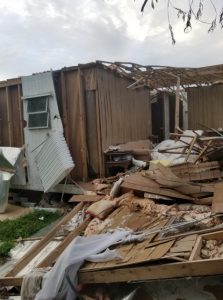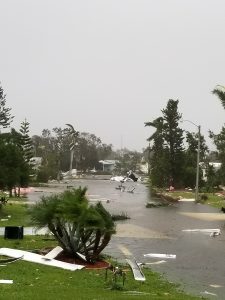MH Pros Go in Search of Answers on Florida Manufactured Housing Post-Irma
In the days following Hurricane Irma, a team of unlikely documentarians hit the soggy ground in South Florida searching for answers on manufactured housing post-Irma.
They handed out water and rations, called when they could to notify emergency workers of stranded or distressed residents, and offered plenty of blessings and well wishes too.
However, the line of questioning most often, and where the cameras were trained, had more to do with homes that remained rather than those wiped out.
Leading the team was Jim Ayotte, Executive Director of the Florida Manufactured Housing Association.
“The industry fared much better than we anticipated,” Ayotte said following the visit to six communities in Naples and Bonita Springs, Fla. “There were fewer damaged and destroyed home than expected.
“The new product performed extremely well,” he said. “We did not find one home that was built and sited after 1994 that suffered any significant damage. Maybe a roof shingle or two that had come loose, but that was about it.”
A roof shingle or two, amid the piles of rubble, splintered lumber and debris that continues to fill front yards and line streets in some areas.

A Report from Storm-Damaged South Florida
An estimated 77 people died in or from the aftermath of the storm. Area emergency rooms a month later continued to see double the normal traffic; storm victims with severe dehydration, slip and fall injuries, or trauma from working to move debris.
“A lot of site-built homes had roofs missing, holes in roofs, blown windows,” Ayotte said. “There were boats and RVs stacked up on the side of the road. The amount of destruction in general was amazing.”

Older manufactured homes, Ayotte said, sustained damage, most often from attached structures pulling up from high winds, and ripping away siding or roofing fascia. But even those sustained only minor damage to the primary structure. FMHA continues to ask for input from residents, community managers and owners.
Ayotte said he saw two homes that shifted on their foundations.
“We had a good cross-section of the industry, and we met with a lot of community owners and home owners,” Ayotte said. “I was amazed at how upbeat and resilient these people were.
“We really believe that we have a great product, and these storms give us the opportunity to assess the industry and affirm that we’re building and siting the homes that we want to have out there. These homes are performing just as we want them to perform.”
How One Couple Survived Irma
John Jenkins is one of the homeowners Ayotte and his team ran across during their first tour of Florida manufactured housing post-Irma.
Jenkins, his girlfriend Susie and their dog BO, waited nervously in their 2017 Destiny home, which had been delivered and installed at Riverwood Estates in Naples only a few months prior. They watched the reports as the storm shifted and hopped west. And then they went from nervous to concerned, or something just shy of scared.
The couple placed a call to Jeff Wagner, from GTS Homes. Wagner had installed the home, and answered the call. He assured Jenkins that the home was sturdy and anchored tight.
“There was nowhere to go,” Jenkins said. “If you go north, that’s the track for the hurricane. If you go east, all of those people were coming toward us. It really surprised us. We were supposed to be out of the way. But Jeff assured me that everything was new and in place. He thought we’d be OK.”
‘Serenity inside this home’
“We watched that thing come up on us, we stayed in it as the eye came over top of us, then it hit again and scraped right across before swinging northeast again,” Jenkins said. “The fierceness of the outside made the relative calm and serenity inside this home very surreal. It was very much in contrast to what was going on outside.”

Jenkins said his home shook a little. He saw a small leak atop the back door, which has since been replaced. His primary concern, he said, was getting hit by flying debris from other structures, automobiles and large trees.
Many homes in his community, he said, though older – from the ’70s and ’80s – stayed on the ground. That’s because of government-funded tie-downs handed out to residents following deadly Hurricane Andrew in 1992.
Even without electrical and other municipal services for 10 or more days following Irma, which made landfall on Sept. 10, Jenkins and his girlfriend felt relatively fortunate.
True, they had damage to the skirting. But, the home and all Jenkins invested in it is intact.
“You can look out the back of my house and right through the front and through what used to be the living room of my neighbor’s home. That’s the typical story down here, of older built homes,” Jenkins said. “It was definitely an age thing… there’s no comparison.”
Implementation of health and safety standards for Florida manufactured housing:
- 1976 HUD code: Manufactured Home Construction and Safety Standards – Amended/updated several times including most recently in 2015.
- 1999 Florida Installation standards
- 1994 and updated in 2010 High-Velocity Hurricane Zone (HVHZ) —
- FAQ on the safety of Florida manufactured and mobile homes
Manufactured Housing Post-Irma
Bob Qurnell is co-owner of Destiny Home Builders.
“I didn’t have any house that I know of destroyed from this storm, and we sell all the way down to Key West,” Qurnell said. “Our goal is to give the customer the best possible product. I think we did that in this case and in most cases. And the industry as a whole is building and siting quality homes. We can stand to have more people understand that, particularly in the face of media reports that often paint a different picture.”
Qurnell points out that factory-built homes like his have the benefit of weekly inspections from fire marshals, something few site-built homebuilders experience.
“We can’t cut corners even if we wanted,” Qurnell said. “We build a high-quality home with the same shingles, siding, shudders and many other materials used for site-built homes. Those are the points where you can get wind lift in there and the damage can begin.”
To review manufactured housing post-Irma, Ayotte traveled with a videographer/photographer, a member of the marketing team and two representatives, including Qurnell, from noted home manufacturers. FMHA presented the video produced from the first and two subsequent trips to South Florida during the recent National Communities Council in Chicago.
“When we approached him about the storm, he said ‘I felt good.’,” Ayotte said. “We couldn’t have asked for a better testimonial.”












